
Understanding Command Obsessions in OCD
When we talk about Obsessive-Compulsive Disorder (OCD), the conversation often revolves around thoughts and compulsions, the "what-ifs" that can monopolize our minds. However, for many, the reality is much more sinister: intrusive thoughts that operate more like commands than questions. Imagine cooking dinner, and suddenly your mind shouts at you to harm someone. These aren't typical worries; they are command obsessions, intrusive thoughts that demand immediate action, and they can be bewildering and distressing.
In 'OCD Commands I Can't Ignore', the discussion dives into the complex nature of command obsessions, prompting us to delve deeper into strategies for their management.
The Nature of Command Obsessions
Unlike fleeting intrusive thoughts that come and go, command obsessions feel persistent, loud, and often surface at the most inconvenient times. These thoughts, which can include harm or other inappropriate actions, can leave individuals questioning their morality and sanity. It’s crucial to remember that these thoughts do not define who you are. They are symptoms of a disorder that affects many individuals, and recognizing them as part of the mental illness is the first step towards healing.
The Impact of Shame and Stigma
People struggling with command obsessions often face an added layer of difficulty: shame. They may wonder, “What kind of person has thoughts like this?” This shame can serve as a barrier to seeking help and finding support. It’s vital for individuals experiencing these thoughts to understand that they are not alone. Many people have encountered similar experiences, and being open about them can foster connection and encourage others to seek help.
The Approach to Managing Command Obsessions
The good news is that there is hope and effectiveness in treatment. One widely recognized method is Exposure and Response Prevention (ERP). This therapeutic approach involves facing the fears that these command obsessions evoke without acting on them, allowing the thoughts to exist without giving them power. It’s about recognizing the thoughts as benign and learning not to react impulsively. For example, if feeling compelled to act on a harmful thought, one can acknowledge it, say “maybe,” and continue engaging in daily activities.
Tools for Overcoming Command Obsessions
Managing command obsessions is about reshaping your relationship with intrusive thoughts. Here are some techniques that can help:
- Mindfulness: Practice being present. Acknowledge thoughts without judgement, allowing them to pass like clouds in the sky.
- Grounding Techniques: Use techniques like deep breathing or progressive muscle relaxation to help prevent anxiety surges.
- Cognitive Restructuring: Challenge the validity of fears that these thoughts provoke. Work to recognize irrational thinking patterns.
- Support Groups: Engaging with others who are experiencing similar challenges can provide solace and community.
- Therapeutic Support: Seek help from mental health professionals who specialize in OCD treatment. They can guide you through personalized strategies and coping mechanisms.
The Value of Awareness and Education
Raising awareness about OCD and its various presentations, including command obsessions, is critical. Education breaks down stigma, encourages empathy, and fosters a collective understanding. Whether through personal experiences or informed discussions, these conversations play a pivotal role in dismantling misconceptions surrounding OCD.
Create Change: Understand and Share
In conclusion, dealing with command obsessions can feel overwhelming, but it is crucial to understand that these are symptoms of OCD. With the right tools and support, individuals can learn to manage their thoughts effectively. If you or someone you know is struggling, don’t hesitate to reach out for professional help or connections to support groups. Your journey towards healing doesn't have to be faced alone.
Thank you for taking the time to reflect on this important topic. Remember, if you have thoughts that trouble you, they are just that: thoughts. They don’t have power unless you give it to them. Engage in self-care practices, embrace your worth, and look forward to fostering a more rewarding understanding of your mental health.
 Add Row
Add Row  Add
Add 




Write A Comment